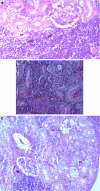Assessment of heavy metal (Cu, Ni, Fe, Co, Mn, Cr, Zn) pollution in effluent dominated rivulet water and their effect on glycogen metabolism and histology of Mastacembelus armatus
- PMID: 24133639
- PMCID: PMC3795878
- DOI: 10.1186/2193-1801-2-390
Assessment of heavy metal (Cu, Ni, Fe, Co, Mn, Cr, Zn) pollution in effluent dominated rivulet water and their effect on glycogen metabolism and histology of Mastacembelus armatus
Abstract
The present study was conducted to examine the contamination of rivulet situated at Kasimpur, Aligarh (27.218° N; 79.378° E). It receives the wastewater of Harduaganj Thermal Power Plant (HTPS) containing fly ash and heavy metals. Among the heavy metals estimated in the rivulet water, Fe (8.71 mgL(-1)) was present in the highest concentration followed by Cu (0.86 mgL(-1)), Zn (0.30 mgL(-1)) Mn (0.21 mgL(-1)), Ni (0.12 mgL(-1)), Co (0.11 mgL(-1)) and Cr (0.10 mgL(-1)). The values for the heavy metals such as Fe, Ni and Mn were beyond the limits set by UNEPGEMS. Bioaccumulation of these heavy metals was detected in tissues such as gills, liver, kidney, muscle and integument of the fish Mastacembelus armatus. Accumulation of Fe (213.29 - 2601.49 mgkg(-1).dw) was highest in all the organs. Liver was the most influenced organ and integument had the least metal load. The accumulation of Fe, Zn, Cu and Mn, observed in the tissues were above the values recommended by FAO/WHO. Biochemical estimation related to blood glucose, liver and muscle glycogen conducted showed significant (p < 0.01) elevation in blood glucose content over control (17.73%), whereas liver glycogen dropped significantly (p < 0.01) over control (-89.83%), and similarly muscle glycogen also decreased significantly (p < 0.05) over control (-71.95%), suggesting enhanced glycolytic capacity to fuel hepatic metabolism. Histopathological alterations were also observed in selected organs (gills, liver and kidney) of Mastacembelus armatus.
Keywords: Bioaccumulation; Glycogen; Heavy metals; Histopathology; Liver; Mastacembelus armatus.
Figures






Similar articles
-
Studies on the oxidative stress and gill histopathology in Channa punctatus of the canal receiving heavy metal-loaded effluent of Kasimpur Thermal Power Plant.Environ Monit Assess. 2015 Jan;187(1):4179. doi: 10.1007/s10661-014-4179-6. Epub 2014 Dec 11. Environ Monit Assess. 2015. PMID: 25492708
-
Accumulation of heavy metals and human health risk assessment via the consumption of freshwater fish Mastacembelus armatus inhabiting, thermal power plant effluent loaded canal.Springerplus. 2016 Jun 18;5(1):776. doi: 10.1186/s40064-016-2471-3. eCollection 2016. Springerplus. 2016. PMID: 27386262 Free PMC article.
-
Stress response of biomolecules (carbohydrate, protein and lipid profiles) in fish Channa punctatus inhabiting river polluted by Thermal Power Plant effluent.Saudi J Biol Sci. 2015 Mar;22(2):237-42. doi: 10.1016/j.sjbs.2014.09.021. Epub 2014 Oct 5. Saudi J Biol Sci. 2015. PMID: 25737659 Free PMC article.
-
Assessment of heavy metal pollution in the agricultural soils, plants, and in the atmospheric particulate matter of a suburban industrial region in Dhaka, Bangladesh.Environ Monit Assess. 2021 Feb 1;193(2):104. doi: 10.1007/s10661-021-08848-y. Environ Monit Assess. 2021. PMID: 33521861 Review.
-
Bioaccumulation of metals in common carp (Cyprinus carpio L.) from water bodies of Anatolia (Turkey): a review with implications for fisheries and human food consumption.Environ Monit Assess. 2016 Apr;188(4):243. doi: 10.1007/s10661-016-5248-9. Epub 2016 Mar 23. Environ Monit Assess. 2016. PMID: 27007291 Review.
Cited by
-
Nutritional value and bioaccumulation of heavy metals in muscle tissues of five commercially important marine fish species from the Red Sea.Saudi J Biol Sci. 2021 Mar;28(3):1860-1866. doi: 10.1016/j.sjbs.2020.12.038. Epub 2020 Dec 31. Saudi J Biol Sci. 2021. PMID: 33732073 Free PMC article.
-
Levels and health risk assessment of heavy metals in dried fish consumed in Bangladesh.Sci Rep. 2021 Jul 19;11(1):14642. doi: 10.1038/s41598-021-93989-w. Sci Rep. 2021. PMID: 34282166 Free PMC article.
-
Deposition of chromium in aquatic ecosystem from effluents of handloom textile industries in Ranaghat-Fulia region of West Bengal, India.J Adv Res. 2015 Nov;6(6):995-1002. doi: 10.1016/j.jare.2014.12.002. Epub 2014 Dec 10. J Adv Res. 2015. PMID: 26644938 Free PMC article.
-
Health risk assessment of PAHs and heavy metal levels in periwinkles (Pachymelania fusca mutans) and crabs (Scylla serrata) consumed in crude oil-contaminated coastal regions of Southern Nigeria.Toxicol Rep. 2024 Dec 13;14:101852. doi: 10.1016/j.toxrep.2024.101852. eCollection 2025 Jun. Toxicol Rep. 2024. PMID: 39802602 Free PMC article.
-
Studies on the oxidative stress and gill histopathology in Channa punctatus of the canal receiving heavy metal-loaded effluent of Kasimpur Thermal Power Plant.Environ Monit Assess. 2015 Jan;187(1):4179. doi: 10.1007/s10661-014-4179-6. Epub 2014 Dec 11. Environ Monit Assess. 2015. PMID: 25492708
References
-
- Agency for toxic substances and disease registry. Clifton Road, Atlanta: Division of Toxicology; 2004.
-
- Agency for toxic substances and disease registry. Clifton Road, Atlanta: Division of Toxicology; 2005.
-
- Standard methods for the examination of water and wastewater analysis, (21st ed.) Washington D.C: American Water Works Association/Water Environment Federation; 2005. p. 289.
-
- Anim EK, Ahialey EK, Duodu GO, Ackah M, Bentil NO. Accumulation profile of heavy metals in fish samples from Nsawam, along the Densu River, Ghana. Res J Environ Earth Sci. 2010;1:56–60.
LinkOut - more resources
Full Text Sources
Other Literature Sources
Research Materials
Miscellaneous

